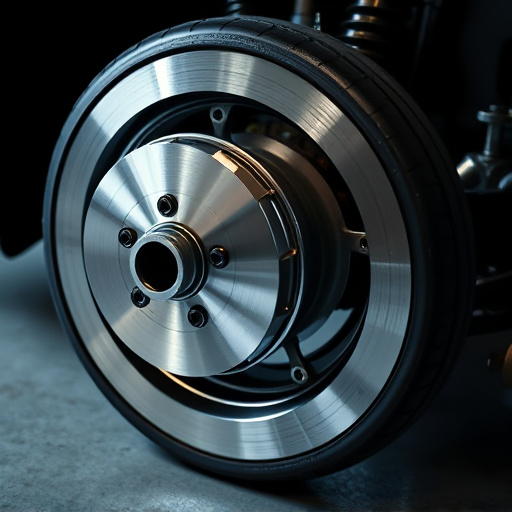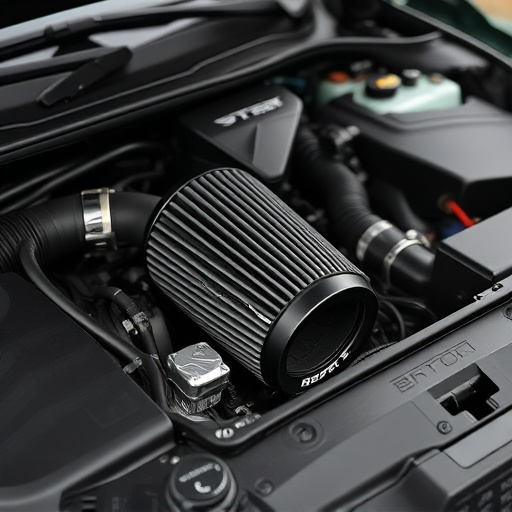Turbo Heat Shields: Unlocking Engine Potential by Cooling Intake Air
Turbo Heat Shields are essential components for turbocharged vehicles, insulating intake air from ex…….
In the realm of engineering and industrial applications, the concept of a turbo heat shield stands out as an innovative solution for managing and mitigating extreme temperatures. This article aims to unravel the intricate details of turbo heat shields, exploring their design, impact, and potential. By delving into this topic, readers will gain valuable insights into a technology that plays a pivotal role in various sectors, from automotive and aerospace to energy generation. We will navigate through historical origins, global adoption, economic implications, technological innovations, regulatory frameworks, and the challenges it faces, ultimately sketching a comprehensive picture of its future prospects.
A turbo heat shield, in its essence, is a specialized thermal insulation component designed to protect machines, systems, and equipment from high-temperature conditions. It operates by creating a barrier between the heat source and the surrounding environment, thereby preventing heat transfer and associated damage. Historically, these shields have evolved from simple insulation materials like asbestos to sophisticated ceramic and metal composites capable of withstanding extreme temperatures exceeding 1500°C (2732°F).
Insulating Material: The heart of a turbo heat shield is its insulating core, typically crafted from advanced materials such as silicon carbide, alumina, or fiber-reinforced ceramics. These materials offer exceptional thermal resistance and stability.
Metal or Ceramic Outer Shell: Enclosing the insulation is a robust outer shell made of metal (e.g., stainless steel) or ceramic composites. This shell provides structural integrity and protection against mechanical impacts.
Sealing Mechanisms: Effective heat shields incorporate sealing technologies to ensure minimal air gaps, enhancing thermal insulation efficiency. These seals prevent hot gases or fluids from leaking through joints or crevices.
The concept of heat shielding has roots in ancient times when early civilizations utilized natural materials like stone and clay to insulate their dwellings against extreme temperatures. However, modern turbo heat shields as we know them today emerged during the space race, where protecting spacecraft from intense heat during re-entry became a critical challenge. This period witnessed significant advancements in materials science, leading to the development of advanced ceramics and fiber composites capable of withstanding extreme conditions.
The adoption of turbo heat shields has transcended geographical boundaries, impacting various industries globally. Key trends shaping its trajectory include:
Automotive Industry: With a growing focus on electric vehicles (EVs) and hybrid cars, turbo heat shields are essential for managing the high temperatures generated by powerful batteries and motors. This trend is driving innovation in lightweight and efficient insulation materials.
Aerospace Sector: The aerospace industry continues to push the boundaries of space exploration, leading to more demanding thermal management requirements. Turbo heat shields play a crucial role in protecting spacecraft, satellites, and aircraft from extreme temperatures during launch, orbit, and re-entry.
Energy Generation: Power plants, especially those utilizing advanced nuclear and renewable energy technologies, rely on robust heat shielding for their critical components. This demand is expected to grow with the global shift towards cleaner energy sources.
Regional Disparities: While developed countries like North America, Europe, and Japan lead in turbo heat shield technology adoption, emerging markets such as China, India, and Brazil are rapidly gaining momentum. These regions’ industrialization and infrastructure development drive the demand for advanced thermal management solutions.
The global turbo heat shield market is a dynamic and expanding sector, fueled by various economic factors:
Market Size: According to industry reports, the global heat insulation materials market, encompassing turbo heat shields, is projected to reach USD 26.7 billion by 2025, growing at a CAGR of 7.8% from 2020 to 2025 (Source: MarketsandMarkets). This growth is primarily attributed to the increasing demand from the automotive and aerospace industries.
Investment Patterns: Major players in the turbo heat shield market include both established companies and emerging startups. These firms invest heavily in research and development, aiming to create lighter, more efficient, and cost-effective products. Notable examples include 3M, Insulco, and Ceravise.
Economic Impact: The production and use of turbo heat shields contribute to economic growth through job creation, technology transfer, and export opportunities. Additionally, the demand for these shields drives related industries, fostering a network of suppliers and service providers.
The field of turbo heat shielding has witnessed several groundbreaking technological advancements, propelling it into the future:
Nanotechnology: The integration of nanotechnology into heat shield design allows for the creation of ultra-lightweight materials with enhanced thermal properties. Nanocomposites can offer better insulation and mechanical strength, making them ideal for next-generation applications.
3D Printing: Additive manufacturing techniques, such as 3D printing, enable the production of complex heat shield geometries tailored to specific requirements. This technology reduces material waste and allows for faster prototyping and customization.
Smart Materials: Researchers are exploring ‘smart’ materials that can actively respond to temperature changes, expanding or contracting to optimize thermal performance. These adaptive materials could revolutionize heat shielding by providing self-regulating insulation.
Advanced Coating Technologies: New coating formulations offer improved durability, corrosion resistance, and enhanced thermal barrier properties. These coatings can extend the lifespan of heat shields, reduce maintenance needs, and enhance overall system efficiency.
The development and deployment of turbo heat shields are subject to various policies and regulations, ensuring safety, environmental protection, and sustainable practices:
Space Industry Regulations: For aerospace applications, organizations like NASA and the European Space Agency (ESA) have established guidelines and standards for heat shield design and testing. These include specifications for thermal protection systems in spacecraft re-entry.
Environmental Standards: In many regions, there are strict regulations governing the use of certain materials to prevent environmental contamination. For instance, the European Union’s REACH (Registration, Evaluation, Authorization, and Restriction of Chemicals) regulation ensures that heat shield components meet safety and sustainability criteria.
Safety Standards: Industries such as automotive and energy generation have their own safety standards and protocols for heat shield installation and maintenance, ensuring worker protection and equipment integrity.
Despite its many advantages, the turbo heat shield technology faces several challenges and criticisms that require attention:
Cost: Advanced turbo heat shields can be expensive, especially those tailored for specialized applications. Lowering production costs without compromising performance remains a significant challenge.
Weight: In some cases, traditional heat shield designs may add considerable weight to systems, which can be detrimental in space exploration and automotive efficiency goals. Lighter materials and optimized designs are needed to address this issue.
Durability: Extreme environmental conditions, such as thermal shock and mechanical vibrations, can pose challenges to the longevity of heat shields. Enhancing their resistance to these factors is crucial for reliable performance over time.
Recycling and Disposal: The disposal and recycling of turbo heat shield materials, especially advanced ceramics, present environmental and economic considerations. Developing sustainable end-of-life management strategies is essential.
Actionable Solutions:
The following case studies highlight the practical applications and benefits of turbo heat shields:
Case Study 1: NASA’s Mars Perseverance Rover:
NASA’s Perseverance rover, landing on Mars in 2021, relied on advanced thermal protection systems (TPS) to survive the planet’s harsh conditions. The TPS included a multi-layer heat shield designed to protect the rover during its high-speed entry and descent through Mars’ thin atmosphere. This system successfully withstood temperatures exceeding 2400°F (1315°C), demonstrating the effectiveness of turbo heat shielding in extreme environments.
Case Study 2: Electric Vehicle Battery Systems:
A major automotive manufacturer faced the challenge of managing heat generated by high-performance lithium-ion batteries in their electric vehicles. By integrating custom-designed turbo heat shields around the battery packs, they achieved significant temperature control improvements. This led to enhanced battery life, improved safety features, and better overall vehicle performance.
Case Study 3: Solar Power Plant Insulation:
A leading solar energy company implemented advanced ceramic turbo heat shields on their concentrated solar power (CSP) plants. These shields protected the high-temperature receivers from environmental elements, ensuring consistent and efficient energy generation. The result was a 15% increase in overall system efficiency and reduced maintenance costs.
The future of turbo heat shielding presents a promising landscape filled with growth opportunities and emerging trends:
Advanced Materials: The continuous development of new materials, such as graphene-based composites and advanced ceramics, will drive performance improvements and weight reductions. These materials offer unparalleled thermal properties and mechanical strength.
Integration with Smart Systems: Turbo heat shields are poised to integrate with smart sensors and control systems, enabling real-time monitoring and adaptive thermal management. This integration could lead to more efficient and responsive industrial processes.
Space Exploration Advancements: With ongoing missions to the Moon and Mars, there will be an increased demand for advanced heat shielding technologies to protect spacecraft and equipment in harsh extraterrestrial environments.
Sustainability Focus: As environmental concerns grow, the development of eco-friendly heat shield materials and sustainable production processes will gain prominence. This shift aligns with global efforts to reduce carbon footprints.
Turbo heat shields have emerged as indispensable components in numerous industries, playing a critical role in managing extreme temperatures. From their historical evolution to current global applications, these shields continue to push the boundaries of thermal management. As technology advances and industries adapt, turbo heat shielding will remain a cornerstone of innovative solutions, enabling us to navigate hotter environments—both literally and metaphorically—with confidence.
Q: How do turbo heat shields differ from traditional insulation materials?
A: Turbo heat shields are designed for extreme temperature conditions and often incorporate advanced composite materials that offer superior thermal resistance compared to conventional insulation. They are engineered to withstand high temperatures (up to 1500°C/2732°F) while maintaining structural integrity. Traditional insulation, while effective for milder applications, may not be suitable for such demanding environments.
Q: What makes nano-based heat shields better?
A: Nanotechnology enables the creation of ultra-lightweight materials with exceptional thermal properties. Nano-infused composites can provide superior insulation and mechanical performance, making them ideal for next-generation turbo heat shield applications. Their small particle size allows for precise control over material properties, leading to more efficient thermal management.
Q: Are turbo heat shields expensive to install?
A: The cost of installing turbo heat shields depends on the application’s specific requirements and scale. While specialized heat shields may carry a higher price tag, advanced manufacturing techniques and materials science advancements are driving cost reductions. Additionally, the long-term benefits in terms of improved equipment lifespan and energy efficiency can offset initial investment costs.
Q: How do turbo heat shields contribute to environmental sustainability?
A: Turbo heat shields play a role in sustainability by enabling more efficient industrial processes, reducing waste heat, and minimizing environmental impact. Advanced materials development and recycling initiatives further enhance their eco-friendly credentials. For instance, using lightweight materials can decrease the overall energy required for transportation, leading to lower carbon emissions.

Turbo Heat Shields are essential components for turbocharged vehicles, insulating intake air from ex…….

Turbo heat shields are crucial components for turbocharged vehicles, protecting against excessive he…….